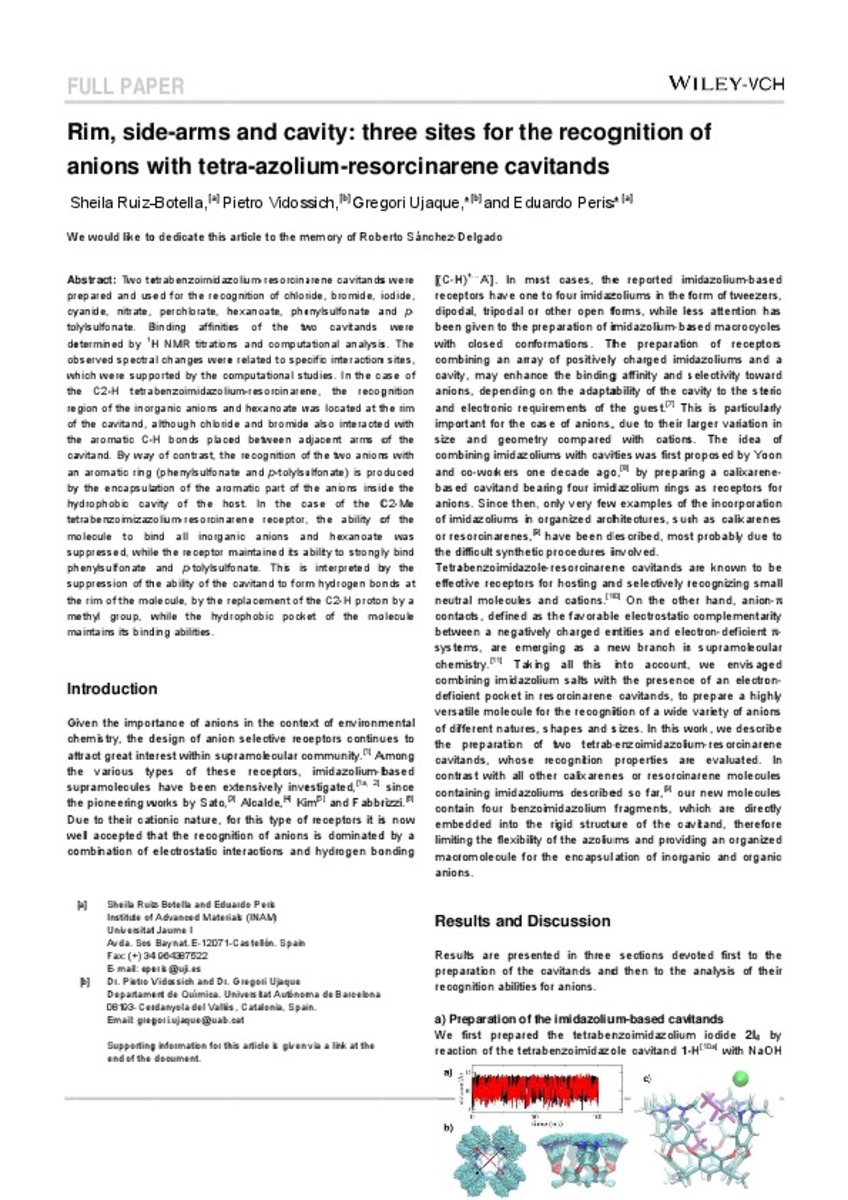| dc.contributor.author | Ruiz-Botella, Sheila | |
| dc.contributor.author | Vidossich, Pietro | |
| dc.contributor.author | Ujaque, Gregori | |
| dc.contributor.author | Peris, Eduardo | |
| dc.date.accessioned | 2016-11-29T13:02:02Z | |
| dc.date.available | 2016-11-29T13:02:02Z | |
| dc.date.issued | 2016-09 | |
| dc.identifier.citation | RUIZ‐BOTELLA, Sheila, et al. Rim, Side Arms, and Cavity: Three Sites for the Recognition of Anions by Tetraazolium Resorcinarene Cavitands. Chemistry-A European Journal, 2016, vol. 22, no 44, p. 15800-15806. | ca_CA |
| dc.identifier.uri | http://hdl.handle.net/10234/164804 | |
| dc.description.abstract | Two tetrabenzoimidazolium-resorcinarene cavitands were prepared and used for the recognition of chloride, bromide, iodide, cyanide, nitrate, perchlorate, hexanoate, benzenesulfonate, and p-toluenesulfonate. Binding affinities of the two cavitands were determined by 1H NMR titration and computational analysis. The observed spectral changes were related to specific interaction sites, which were supported by the computational studies. In the case of the C2−H tetrabenzoimidazolium-resorcinarene, the recognition region of the inorganic anions and hexanoate was located at the rim of the cavitand, although chloride and bromide also interacted with the aromatic C−H bonds located between adjacent arms of the cavitand. By contrast, the recognition of the two anions with an aromatic ring (benzenesulfonate and p-toluenesulfonate) results from encapsulation of the aromatic part of the anions inside the hydrophobic cavity of the host. In the case of the C2−Me tetrabenzoimizazolium-resorcinarene receptor, the ability of the molecule to bind all inorganic anions and hexanoate was suppressed, but the receptor maintained its ability to strongly bind benzenesulfonate and p-toluenesulfonate. This is interpreted in terms of suppression of the ability of the cavitand to form hydrogen bonds at the rim of the molecule due to replacement of the C2−H proton by a methyl group, while the hydrophobic pocket of the molecule maintains its binding abilities. | ca_CA |
| dc.description.sponsorShip | We gratefully acknowledge financial support from MEC of Spain (CTQ2014-51999-P and CTQ2014-54071-P) and the Universitat Jaume I (P11B2014-02). We are grateful to the Serveis Centrals d'Instrumentació Científica (SCIC) of the Universitat Jaume I for providing spectroscopic facilities. We would also like to thank the Generalitat Valenciana for a fellowship (S.R.-B.). | ca_CA |
| dc.format.extent | 6 p. | ca_CA |
| dc.format.mimetype | application/pdf | ca_CA |
| dc.language.iso | spa | ca_CA |
| dc.publisher | Wiley | ca_CA |
| dc.relation.isPartOf | Chemistry-A European Journal, 2016, vol. 22, no 44 | ca_CA |
| dc.rights | Copyright © 1999 - 2016 John Wiley & Sons, Inc. All Rights Reserved | ca_CA |
| dc.rights.uri | http://rightsstatements.org/vocab/InC/1.0/ | * |
| dc.subject | anions | ca_CA |
| dc.subject | cavitands | ca_CA |
| dc.subject | host–guest systems | ca_CA |
| dc.subject | molecular dynamics | ca_CA |
| dc.subject | molecular recognition | ca_CA |
| dc.title | Rim, Side Arms, and Cavity: Three Sites for the Recognition of Anions by Tetraazolium Resorcinarene Cavitands | ca_CA |
| dc.type | info:eu-repo/semantics/article | ca_CA |
| dc.identifier.doi | http://dx.doi.org/10.1002/chem.201602916 | |
| dc.rights.accessRights | info:eu-repo/semantics/openAccess | ca_CA |
| dc.relation.publisherVersion | http://onlinelibrary.wiley.com/doi/10.1002/chem.201602916/full | ca_CA |







